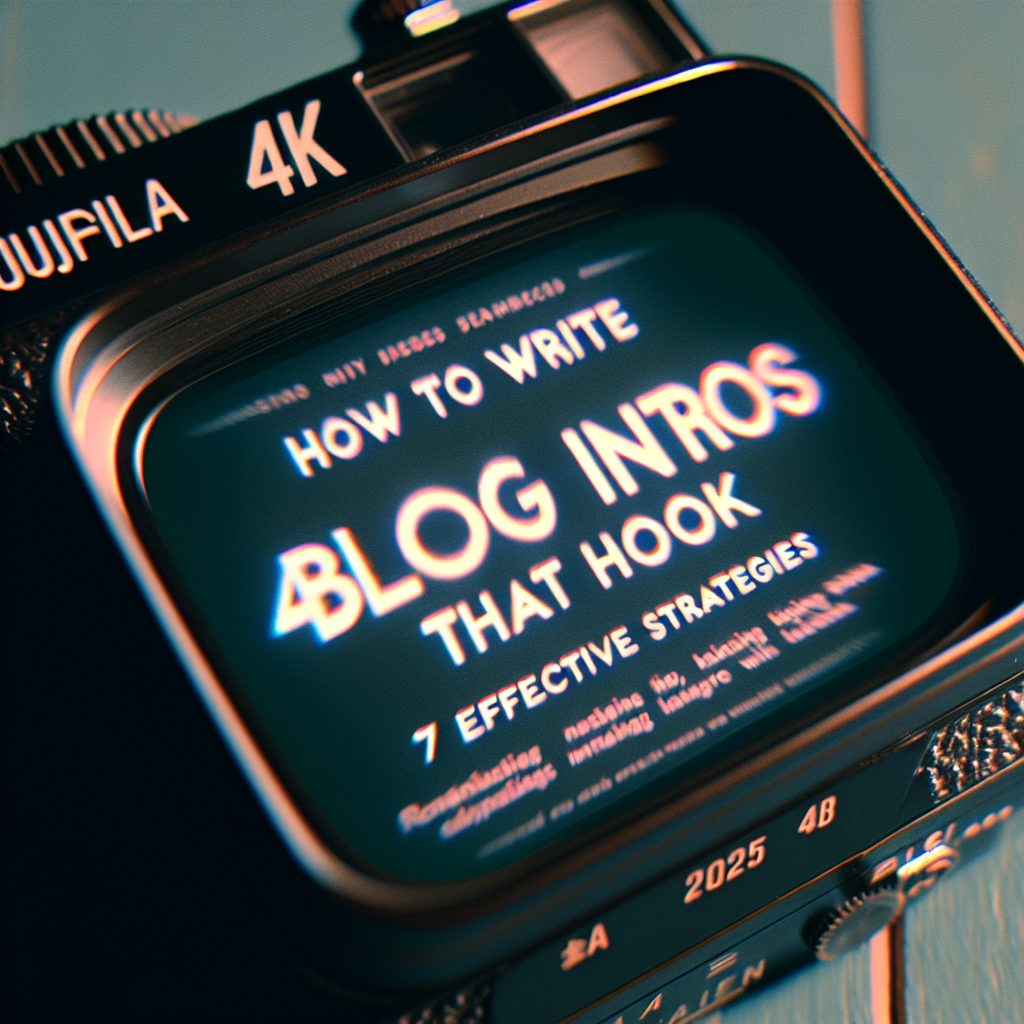How to Write Blog Intros That Hook: 7 Effective Strategies for 2025
- 1. Craft a Compelling Hook Right Away
- 2. Tell an Engaging Story or Anecdote
- 3. Ask Provoking Questions
- 4. Use Surprising Statistics or Facts
- 5. Communicate Clear Value and Benefits
- 6. Employ Strong, Actionable Language
- 7. Keep Intros Short and to the Point
1. Craft a Compelling Hook Right Away
Using a Bold Opening Statement
In 2025, capturing your readerâs attention starts with a powerful, bold opening. An attention-grabbing statement immediately draws interest, making your audience eager to read more. For example, starting with a startling fact or a provocative claim can pique curiosity and set the tone for your entire blog post.
This approach works because people naturally seek content that offers immediate value or intrigue. Think of it like headline writingâyour intro should promise a benefit or spark curiosity. When learning how to write blog intros that hook, remember that a strong start can significantly increase your engagement metrics, including dwell time and shares.
Real example: âDid you know that 80% of blog readers decide whether to continue reading within the first 10 seconds?â Utilizing a compelling statistic such as this in your intro can instantly hook your audience, encouraging them to stay for the deeper insights.
Understanding Your Audienceâs Pain Points
Another effective way to hook readers is by addressing their pain points right at the start. If your audience feels that a blog post speaks directly to their struggles or desires, theyâll be more motivated to continue reading. When figuring out how to write blog intros that hook, consider what your readers care about most and frame your intro to address those needs immediately.
For instance, if you’re writing about productivity, opening with a relatable dilemma like, âStruggling to get through your daily tasks without feeling overwhelmed?â instantly resonates. This approach shows empathy and signals that your content provides solutions.
Research shows that personalized content that hits pain points can increase engagement by up to 50%. So, spend time understanding your audience and craft your intro accordingly.
2. Tell an Engaging Story or Anecdote
Using Personal Stories to Connect
Stories are timeless; they resonate deeply and create an emotional connection. When learning how to write blog intros that hook, starting with a short, relatable story can make your content unforgettable. Personal anecdotes humanize your writing and establish credibility from the outset.
Imagine opening with a brief story about a challenge you faced, then connecting that experience to the bigger topic. This method not only hooks readers emotionally but also demonstrates your authenticity and expertise.
For example, starting with: âA few years ago, I nearly quit blogging because I couldnât find my target audience. Hereâs how I turned things around…â instantly draws readers into your journey, encouraging them to read on for insights and solutions.
Incorporating Storytelling for Higher Engagement
Storytelling in your intro can boost reader engagement significantly. Data from continuous research shows that stories increase information retention by 65% over plain facts. When you tell a story, your audience becomes active participants rather than passive consumers.
Make sure your story aligns with the core message of the post and is concise enough to keep the reader hooked. Using storytelling as a technique on how to write blog intros that hook is proven to boost click-through rates and overall engagement in 2025.
3. Ask Provoking Questions
Engage Readers with Rhetorical or Direct Questions
Asking a thought-provoking question at the start of your blog is a powerful way to engage readers immediately. Questions stimulate curiosity and invite the reader to reflect on their own experiences, creating a sense of participation.
In 2025, using questions like, âAre you making these common SEO mistakes?â or âWhat if you could double your traffic in just 30 days?â can effectively hook your audience. Such questions set up a problem or goal that your content will address.
Effective questions should be relevant, specific, and intriguing. They act as a hook that compels the reader to find out the answer within your post.
Best Practices for Using Questions Effectively
To ensure your questions serve as an effective hook, keep them concise and focused. Avoid vague questions like, âEver wondered about blogging?â instead, opt for targeted queries that relate directly to your content. Data suggests that posts starting with specific questions see higher engagement rates.
Questions also work well when followed by promises of solutionsâthis tactic establishes the value of your content upfront. When considering how to write blog intros that hook, questions are a versatile and effective tool.
4. Use Surprising Statistics or Facts
Leverage Data to Capture Attention
Statistics and surprising facts instantly add credibility and interest to your blog intro. In 2025, data-driven content is increasingly valued, and starting with an eye-opening statistic can hook readers quickly.
For example, âOver 60% of small businesses fail to leverage content marketing effectively,â taps into the concern of your audience and encourages them to continue reading for solutions. Numbers provide tangible proof that your content is relevant and authoritative.
Always verify your data from reputable sources to ensure trustworthiness. Including relevant, recent statistics can also improve your chances of appearing in featured snippets, making your post more visible in search results.
How to Find and Use the Right Data
Research is keyâuse industry reports, surveys, or analytics tools to gather current data relevant to your niche. Incorporate these facts naturally into your intro to avoid sounding like a list of dry numbers. Instead, weave statistics into compelling narratives or questions.
This approach not only hooks readers but also positions you as a credible expert, which is essential in 2025 when audiences are more discerning than ever.
5. Communicate Clear Value and Benefits
State What the Reader Will Gain
People naturally want to know whatâs in it for them. When your intro clearly states the benefits or solutions your post offers, readers are more likely to stay engaged. This is especially true in 2025, where content overload makes brevity and clarity essential.
Start with a promise: âLearn the seven proven strategies you need for writing blog intros that hook in 2025.â This sets expectations and entices the reader to continue for actionable takeaways.
Avoid vague statements and instead be specific about the value your piece provides. Highlighting benefits upfront motivates readers to invest their time in your content.
Using Benefits to Boost Engagement
List the key benefits your reader will receiveâsuch as improved click-through rates, higher reader retention, or increased sharing. When these are upfront, your intro becomes a compelling reason to keep reading. Always tailor your hooks to what your audience values most.
This strategy aligns with best SEO practices and ensures your content is aligned with what your target audience searches for and cares about in 2025.
6. Employ Strong, Actionable Language
Use Powerful Verbs and Clear Calls to Action
In your blog intro, choose verbs that inspire actionâlike âdiscover,â âlearn,â âmaster,â or âboost.â This type of language energizes the reader and sets an active tone for your article.
For example, âDiscover the secrets to writing blog intros that hook your audience instantlyâ is more compelling than a passive statement. Actionable language encourages the reader to see your post as a resource they can directly apply.
In 2025, fine-tuning your language to be both assertive and inviting can dramatically improve engagement and conversion rates.
Creating a Sense of Urgency
Adding urgencyâsuch as âStart now,â or âBefore itâs too lateââcan motivate immediate action. When your intro emphasizes timely value, readers are more likely to continue reading and engaging with your content.
Ensure that the language remains friendly and genuine; overhyped or clickbait-style phrasing can harm your credibility. Use strong, honest language that aligns with your brand voice.
7. Keep Intros Short and to the Point
The Power of Brevity
Long-winded intros can lose the readerâs interest quickly. In 2025, the best blog intros are conciseâideally under 3-4 sentencesâwhile still delivering value and hooks. Clarity is essential.
Focus on one compelling idea or hook per intro paragraph. Use straightforward language to quickly communicate the topic and its importance. This respects your audienceâs time and increases the likelihood of them reading your entire post.
Remember, the goal of knowing how to write blog intros that hook is to grab attention fastâthen deliver valuable content that keeps the reader engaged throughout.
Conclusion
Mastering how to write blog intros that hook is crucial to increasing your blogâs visibility and engagement in 2025. Implementing these seven strategiesâcrafting compelling starts, telling stories, asking questions, leveraging statistics, communicating clear value, using strong language, and keeping intros conciseâwill set you apart from the crowd. Remember, the first impression counts, and a powerful intro can make all the difference between a bounce and a loyal reader. Invest time in creating compelling blog intros that hook from the very first sentence, and watch your audience grow!
Frequently Asked Questions
1. Why is the intro so important in blogging?
The intro sets the tone for your entire post. It captures attention, establishes relevance, and encourages readers to continue. In 2025, a strong introduction is even more vital because of increasing content competition.
2. How to write blog intros that hook quickly?
Use a mix of compelling questions, surprising facts, stories, or bold statements. Keep it brief, focus on the readerâs needs, and clearly state what they will gain from your post.
3. What are some common mistakes to avoid in blog intros?
Avoid being vague, overly long, or too promotional right away. Don’t neglect to connect with your audienceâs pain points or interests. Keep your introduction relevant and engaging.
4. Can I use humor in my blog intros?
Yes, humor can be effective if relevant and authentic. It can make your intro memorable and approachable but ensure it aligns with your brand and audience tone.
5. How often should I use the keyword phrase ‘how to write blog intros that hook’?
Use the exact keyword phrase in the title, in the first paragraph, in the conclusion, and naturally throughout the content (about 5-7 times total). Balance is key to avoid keyword stuffing while optimizing for SEO.










